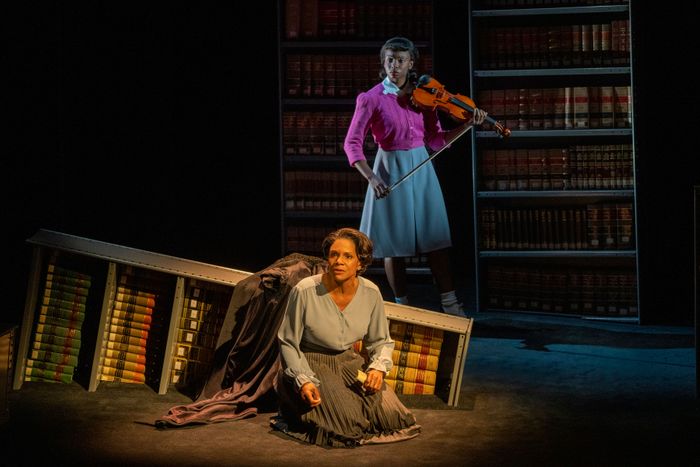
The chill in the James Earl Jones Theatre works its way into your limbs as you watch Ohio State Murders. The freshly renovated house has better airflow than before, but really the chill is emanating from the play itself. There’s snow, seen in a projection falling into a deep ravine in the back of Beowulf Boritt’s set, and there’s a halting, slightly fluttering reticence in Audra McDonald’s voice, the sense behind her eyes that she has experienced something that has frozen her soul. Over the course of the play, we in the audience learn exactly what that horror was, the realization fanning over the theater like ice crystals across a gradually freezing pond.
McDonald’s character, Suzanne, has come to Ohio State to deliver a lecture about the violent imagery in her work: “Blooded heads, severed limbs, dead father, dead Nazis, dying Jesus,” she recites in a tone so clipped it is nearly deadpan. Her affect is a near-imitation of the playwright Adrienne Kennedy herself, who is making her Broadway debut at 91 with this production (Ohio State Murders itself was first performed in 1992) and who modeled the recurring character of Suzanne largely upon herself. The fictional Suzanne, like Kennedy, attended Ohio State in the years around 1950, and both fell in love there with great works of English literature, including Tess of the d’Urbervilles, and ran up against the entrenched racism of the institution. Not long after the beginning of the 75-minute play, Suzanne tells you that her twin daughters will be found dead a year and half after she starts school, one of the moments that Kennedy deploys like a depth charge, suddenly unsettling your sense of the story being told. McDonald plays both the older version of the character and, with a flourish and a removal of her coat, the younger student, parts that have been performed by separate actors in the past. This a bravura turn from someone whose virtuosity is inarguable—in a flex, McDonald’s Playbill bio doesn’t even mention her six Tony awards—but who can still surprise you with an acute gesture, like the way she stretches a crinkled piece of paper before continuing to speak.
With a performer that capable, you want the rest of the production to rise to her level, but Kenny Leon’s direction seems to let McDonald down. For an Adrienne Kennedy play, Ohio State Murders is relatively straightforward—no guest appearances from Queen Victoria and a Hapsburg, as in Funnyhouse of a Negro; no metaphorical rodents, as in A Rat’s Mass—but Leon seems torn between embracing the text’s more avant-garde elements and taking it literally, maybe too literally. Suzanne’s roommate, Iris Ann (Abigail Stephenson), is a violinist, and enters a scene playing a mournful, stately tune. When she and Iris Ann go to a screening of Battleship Potemkin, the Odessa Steps sequence is simply projected right on top of them. You want something with more ideas, rising to dance with Kennedy’s often elliptical narrative. In one of the more abstract aspects of this staging, a pair of pink scarves stand in for Suzanne’s baby girls. McDonald does lovely work treating each as if it were a child, but it’s out of step with direction that otherwise feels as if it is treating Ohio State Murders as a crime story.
Or perhaps Leon, taking such a polite and gloved approach, is just treating the play reverentially, as if it is a classic, which it is and it isn’t. Yes, Kennedy’s work has been deeply influential; you see her impact in depicting the internal mental cacophony of racism in the work of Jeremy O. Harris or Suzan-Lori Parks—whose Topdog/Underdog has itself just been revived on Broadway by Leon in a production with shimmering performances and rather rote direction. Kennedy’s work needn’t be treated with such reverence, and itself actively interrogates the idea of a “classic.” Laced through Ohio State Murders are Suzanne describes watching her professor Robert Hampshire (Bryce Pinkham, wound tight) lecture on Thomas Hardy and King Arthur. These classics move her, but she feels a distance from them—as a Black woman, she has to take a trial course, pretty much designed for her to fail, as an audition toward majoring in English. The canon, like the sorority row she describes in one of several speeches about the unsettling geography of the university, is not a place she can inhabit.
It’s a fascinating thing that Kennedy’s work is coming to Broadway at all, especially in the form of a play so much about white institutions. That description of the layout of Ohio State could easily be transposed into a description of the layout of the midtown theater district, superficially welcoming but prim and exclusionary underneath. This production, like the young Suzanne, feels as if it is working to accommodate the expectations of the industry, with its careful staging and public emphasis on the historic aspect of Kennedy’s debut. Audio interviews with the playwright play before the curtain rises, and the cast salutes a photo of her during their bows. You are left with the feeling of wishing for something stranger, and also of seeing those accommodations more clearly. You hope this is an entrée into more productions of Kennedy’s work, ones that take her ideas further. You also ponder whether that need to fit in is self-enforcing, whether there’s a way out that’s less incremental. That’s part of the chill that this work conjures, too. It feels as if Kennedy herself has seen all this from a distance, and already predicted the weather patterns. She leaves us here, uncertain, in the snow.
Ohio State Murders is at the James Earl Jones Theatre through February 12.


